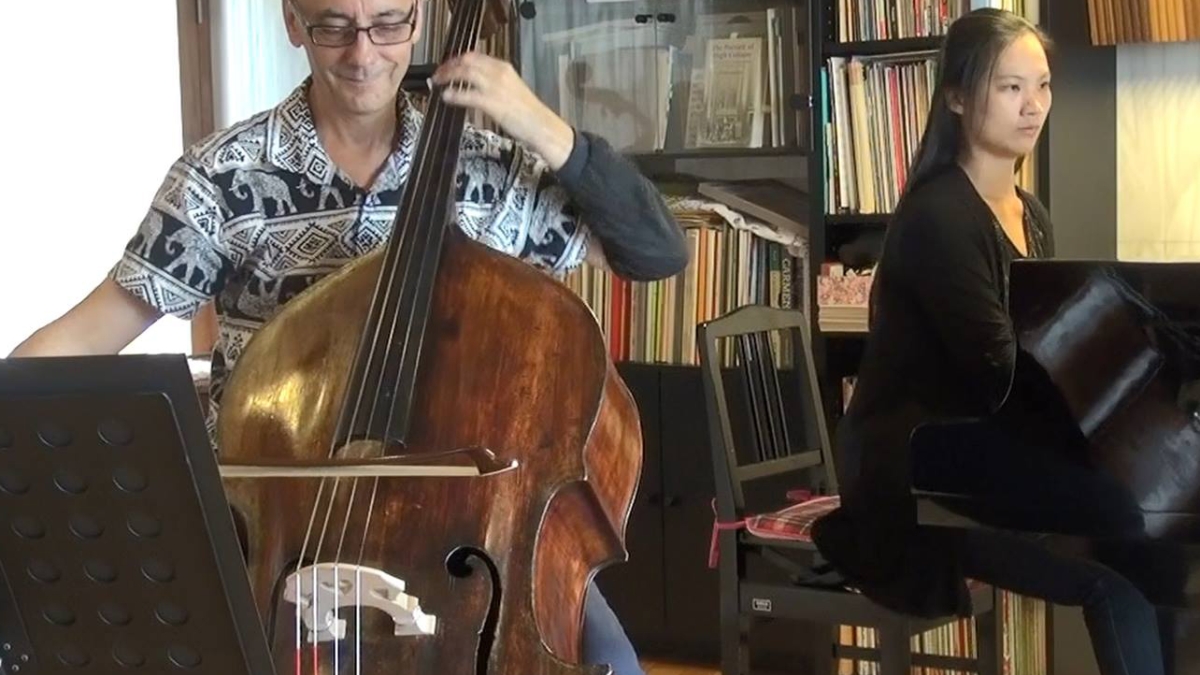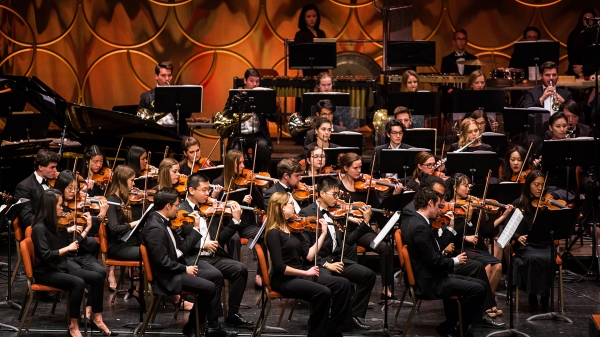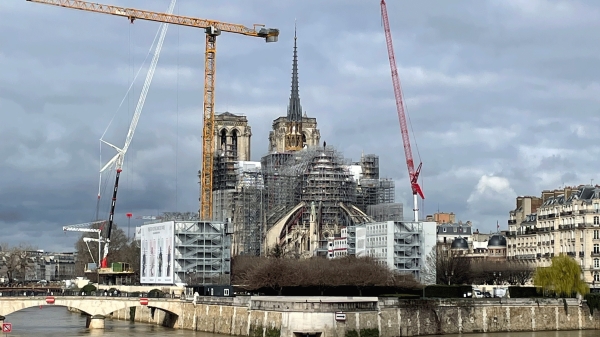ASU music professor brings legendary, 300-year-old instrument back to life

Catalin Rotaru plays the Bottesini double bass in July in the Japanese home of instrument owner Hiroyuki Tokukata.
Catalin Rotaru, an Arizona State University School of MusicThe School of Music is in the Herberger Institute for Design and the Arts. associate professor, was afforded the rare opportunity to bring the music and spirit of legendary Italian composer and virtuoso Giovanni Bottesini — and his mythical instrument — back to life.
As a double bass teacher, clinician and performer, Rotaru has had the opportunity to teach throughout North and South America, Europe and Asia and meet with several leading teachers and performers of the double bass. Recently he was selected by the private owner of Bottesini’s double bass, Hiroyuki Tokukata, to play the composer's renowned instrument and record some of his compositions.
Bottesini (1821–1889) is considered the most important and influential figure in the double bass world. The conductor, composer and virtuoso performer paved the way for the double bass to be viewed as a diverse instrument with solo capabilities. His status is legendary among bassists worldwide.
The instrument played by Bottesini has its own identity and iconic status shrouded in mystery. It was made by Carlo Antonio Testore in 1716, and Bottesini performed with the double bass around the world — Havana, Buenos Aires, Cairo, London, Milan and Boston. It is documented by those who were privileged to hear Bottesini play that the instrument has a very special and enchanting tone.
There are no known previous recordings of Bottesini’s instrument. The significance of Rotaru’s recording in July in Japan recording transcends the music itself as it also reveals the spirit of Giovanni Bottesini.
“It was a great, great honor to play this instrument, and I was humbled by this experience,” Rotaru said. “It was a magical experience because I have studied Bottesini’s works since I started to play bass, but playing the instrument on which he composed these pieces is like a revelation. The instrument that produced the sound that was heard when recording the pieces was played God knows how many times — tens, hundreds of times — and it’s the instrument on which he composed those pieces. It is mythical for me and a magical experience.”
The Bottesini bass is such a valuable instrument that the current owner would not allow the double bass to be taken outside his house for the recordings. Since 1974 the instrument has not been seen publicly.
Rotaru said there are two main reasons the opportunity to play the Bottesini double bass was so special.
“First of all, it was built by the very famous luthier, Carlo Antonio Testore,” Rotaru said. “There were only a few other prominent string-instrument makers in Italy at that same time and era, such as Stradivarius. People have heard about Stradivarius because of the amazing violins he created. Stradivarius also created cellos, but no basses.”
Testore’s double bass ceased being played in the 1830s and was later discovered backstage in a marionette theater in Milan, where Bottesini found and purchased it in 1838.
“Testore had made a few other double basses during his lifetime, but this double bass is particularly special because of who played it,” Rotaru said. “It is because Bottesini himself acquired the instrument when he was less than 20 years old and a student in the Milano Conservatory. At that time the instrument was already over 100 years old.”
Rotaru said he discovered paper tags inside the instrument. Testore, like every instrument maker at that time, had put his name inside the instrument on a little piece of paper. He said he could also see some repairs tags done by various luthierssomeone who builds or repairs string instruments generally consisting of a neck and a sound box; one is from as far away as South America.
Bottesini played the instrument throughout his life, including when he toured the world, Rotaru said. He also said it is well known that Bottesini was very good friends with the famous opera composer Giuseppe Verdi and that Bottesini conducted the first premiere of the famous opera "Aida" in Cairo, Egypt.
He said Bottesini revolutionized the double bass’s place in music because of his approach. Before Bottesini, there were two distinct compositional elements that were not present or emphasized in previous solo literature for double bass. One is the use of harmonics — a particular sound accomplished on a string instrument by gently touching the strings without pressing it down on the fingerboard. The other is the introduction of aria-like melodies or passages, which is why Bottesini’s solo literature for double bass is considered so operatic.
“What Bottesini brought into the double bass and why I consider him a pioneer, a revolutionary in the double bass technique, is the way we play today — the introduction of harmonics combined with lyricism of the actual passages,” Rotaru said.
Rotaru compared Bottesini to Einstein, saying that “just like Einstein’s theory revolutionized modern physics, the same way Bottesini revolutionized the way we play this instrument today.”
He said he believes that the Bottesini recording project is historic because it is the first time to not only see the magnificent instrument but, most importantly, to hear the sound it produces. He said he also believes the project will help bridge local and international communities of double bass players.
This project was partially funded by a Herberger Institute for Design and the Arts project grant with supporting contributions from the ASU School of Music and included the making of a short documentary film during the actual recording.
The recorded project will be available in physical CD and downloadable format at a minimal cost. The downloadable format is available now on the CD label website, Soundset Recordings. The physical CD will be available soon for shipping on the same website.
More Arts, humanities and education

ASU Symphony Orchestra welcomes visionary conductor Jonathan Taylor Rush
Guest conductor Jonathan Taylor Rush will join Arizona State University’s Jason Caslor, director of bands, to lead the ASU…

Chemistry classes are key to art student's success
Amanda Barnette has a passion for art preservation. That means that, for the past four years, the Arizona State University…

ASU+GSV Summit tackles big questions about AI, technology, education
Editor's note: We'll be updating this story daily throughout the summit. The annual ASU+GSV Summit kicked off in San Diego on…